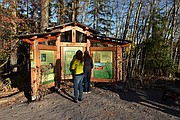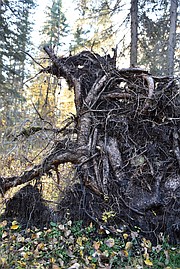Renown scientists gather in Whitefish for sake of Montana lakes
The Whitefish Lake Institute held the Montana Lakes Conference last week at the Lodge in Whitefish. The theme for the 2023 Montana Lakes Conference was “Montana Lakes at Risk; Challenges and Opportunities.”
The two and a half day event hosted over 40 Montana lake and aquatic ecology experts including Jim Elser, nationally renowned lake ecologist and director of the Flathead Biological Station, as well as guest speakers from out of state.
On Thursday, Mike Koopal, founder and executive director of the Whitefish Lake Institute, led a guided walk through the Viking Creek Wetlands. After a brief introduction, the walk commenced with frequent stops so he could share stories of the trail along the way.
“The Averill family donated the 28.82 acres to Whitefish Lake Institute and our mission is to protect it in perpetuity for water quality, natural resources and community,” Koopal said. “We took ownership of the wetlands in 2009 … and we were able to put in the public interpretive trail [which] opened in 2013.”
Koopal said that to the north and east of the Institute’s 28 acres is a nature conservancy of about 220 acres. Together, the parcels form a large contiguous area of wildlife habitat.
He told the group that Whitefish Lake Institute hosts fifth-graders at the Viking Creek Nature Trail for three full days each year. Partner groups like the Flathead Basin Commission, Wild Wings Recovery Center, and Fish, Wildlife and Parks operate educational stations for the students and it is a memorable time for all.
Once on the trail, the group of about 30 walked on crunchy leaves along the winding path and enjoyed the sights and smells of black cottonwoods, aspens, shallow-rooted spruce trees and western skunk cabbage.
During a stop, Koopal fielded questions and was asked what he loves most about the Viking Creek Wetland Preserve. He said he likes the fact the nature trail provides a community amenity and it’s nice to see young families using the trail.
“When you’re a water quality organization, it’s kinda hard to get that hook into people,” he said as the crowd nodded in understanding.
Koopal said that when people ask him what he does as a water quality organization and he tells them he fills bottles of water and tracks trends, they nearly fall asleep. The sympathetic crowd chuckled politely.
“This is a tangible thing for the community to come see and … really, what we’re protecting here is a kidney to Whitefish Lake.” Koopal said. "Viking Creek flows through, and so we are protecting one of the tributaries and, at the same time, all the biodiversity.”
Koopal shared the origin story of the Whitefish Lake Institute. Upon arriving in Whitefish, he said he worked as a consultant and volunteered with an existing Whitefish Lake protection group. After a couple years spent thinking about how to make a water quality organization successful, he cold pitched his idea for the Whitefish Lake Institute to prominent residents and was eventually able to garner more widespread community support.
“I worked for two years without pay to get this organization going, worked six years, and then I was fortunate enough to hire Lori (Curtis) and not pay her very well,” he said with a smile. “Here we are, 18 years later. It’s testimony to having a little vision and just doing the hard work and trying to do the right thing and sometimes that pays off.”
Lori Curtis recently retired from the Whitefish Lake Institute after working for 10 years as its science and education director. She was among the group enjoying the walk.
“When Mike first walked me around this property, he had some serious vision because this place did not look like it would ever be able to have a trail,” Curtis said. “Everything that he’s done with the Whitefish Lake Institute came from a lot of heart and a lot of vision.”
Another conference participant and member of the walking group was Georgia Smies from Polson. Smies is an aquatic biologist and a member of the faculty of the Salish Kootenai College.
“This is a big highlight for me,” Smies said of the conference. “I get to actually meet the people who’ve written the papers I've been reading.”
She often asks the expert scientists to come to Pablo to talk to her students and she’s never had anyone turn her down.
“Last year, Jim Elser, the director of the biostation, came in and presented the phosphorus talk,” she said. “To get someone of Jim Elser’s caliber in front of my students, it's just phenomenal. It inspires my students.”
Smies described another scientist at the conference, Sam Bourret, fisheries biologist with Montana Fish, Wildlife and Parks, as a “really modest guy” with an international reputation for the research he’s done on fish ear stones or otoliths.
“He comes every year and does a lab in my fisheries class with my students. I’m just so grateful,” she said. “This world class guy comes in and teaches my students how to take otoliths out of fish heads and do all the science on them.
“I tell you, lake biologists are nice people. They are generous with their time and their talents,” Smies added. “I’ll keep coming [to the Montana Lakes Conference] until they tell me I can't come anymore.”






